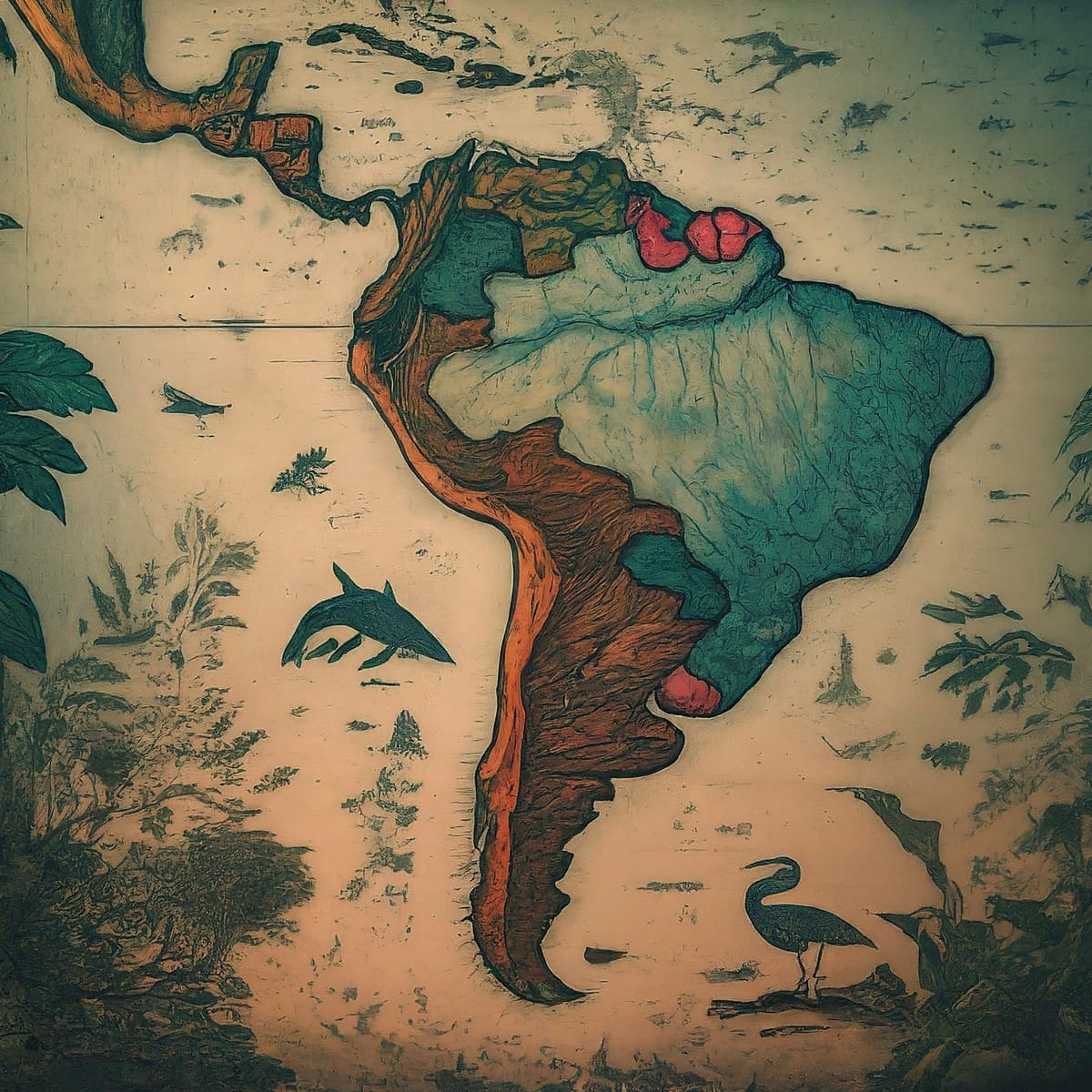From the Andes to the Amazon: How Geography Shapes Latin America

I wouldn't say I liked geography in secondary school. It seemed disconnected from the real world – all about memorising facts and theories. It wasn't until I read 'Guns, Germs, and Steel' that I grasped geography's profound influence on cultures and economies. From there, 'The Prisoner of Geography' fueled my interest even more. Because my work focuses on the Brazilian market, I began exploring Latin America specifically. This led to books like 'Latin America Region and People,' 'The Oxford Handbook of The Brazilian Economy,' and 'Placing Latin America Contemporary Themes in Geography.' I even found helpful introductory websites on the region.
Mental Model
- Topology and Climate: Topological features such as mountains, rivers, highlands, plains, and pampas determine the potential for settlement, connectivity, trade, and conflict. Climate, together with topology, influences water availability, the suitability of growing crops, and the potential for livestock farming.
- Agriculture and Land Distribution: The availability of fertile soil and flat land has historically affected the region's prosperity.
- Natural Resources Distribution: Precious metals like gold and silver, other minerals, oil, and valuable natural resources are closely linked to prosperity. These resources have driven trade and created job opportunities within countries and businesses.
- Language and Food: Language and food are prominent cultural features. Shared language and similar cuisines enhance economic and social connections between people within a region. We may use these features to segment the region into different groups.
- Critical Infrastructure: Highway networks, power transmission infrastructure, ports, airports, and sanitation systems provide the foundational support necessary for economic development.
This is the mental model I began developing over two weeks through in-depth reading and analysis. It's a framework I'm continually refining, but these dimensions seem essential for understanding the region.
Topology and Climate


- Andes Mountains: The most dominant feature, the Andes span the entire western length of South America. This young and seismically active mountain range boasts some of the highest peaks in the world, including Aconcagua in Argentina. They have been a formidable barrier to internal communication and transport, isolating communities and challenging large-scale infrastructural development. The Andes also influence climate patterns and agricultural
- River Basins: Three major river basins shape the continent:
- Amazon Basin: The world's largest rainforest and river system, covering much of northern South America. Its size and ecological significance present both opportunities and challenges for conservation and development. The basin's rivers, particularly the Amazon River, are crucial for transportation, yet the dense jungle has historically limited overland travel and economic exploitation.
- Orinoco Basin: Draining northern South America through Venezuela and Colombia.
- La Plata Basin: Encompassing parts of Brazil, Argentina, Uruguay, Paraguay, and Bolivia, including the Paraná and Paraguay rivers.
- Pampas: The fertile plains of the Pampas, primarily in Argentina, are significant for agriculture, supporting large-scale cultivation of crops and livestock grazing. This area has been a critical driver of Argentina's economy, although it also presents challenges regarding environmental sustainability and land use management.
- Highlands:
- Brazilian Highlands: An extensive system of low mountains and plateaus in eastern South America. The Brazilian Highlands are a treasure trove of valuable natural resources.
- Guiana Highlands: Located between the Amazon and Orinoco river basins, characterised by heavily forested plateaus.
- Coastal Plains: Relatively narrow land strips along the Atlantic and Pacific coastlines. Coastal plains often serve as areas of significant economic activity due to their sea access, facilitating trade, fishing, and tourism. Major cities and ports are typically located on or near these plains, acting as hubs for commerce and communication with the rest of the world.
- Latitude's Fundamental Impact:
- Spans vast range from subtropical to temperate zones, creating the foundation for a mosaic of diverse climates.
- Specific Climate Zones:
- Subtropical:
- Northern Mexico (arid to semi-arid with varying precipitation)
- Mediterranean climates along certain coasts
- Tropical:
- Dominates much of the region
- Year-round rainfall in some areas, distinct wet/dry seasons in others
- Southern Subtropical & Temperate:
- Unique conditions ideal for diverse agriculture
- Subtropical:
- The Andes: Master Shapers of Climate:
- Create rain shadows on their leeward sides, fostering arid zones like the Atacama Desert.
- Drive altitudinal zonation:
- Drastic temperature variations with elevation
- Distinct zones supporting specific vegetation and agricultural practices (e.g., coffee at certain altitudes)
- Ocean Current Influences:
- Shape coastal climates along both Atlantic and Pacific coastlines.
- El Niño Phenomenon: Agent of Disruption:
- Periodically disrupts typical weather patterns across the region.
- Can intensify droughts or trigger severe flooding events.
Agriculture and Land Distribution
- Amazon and Agriculture Challenges:
- Large portions of Brazil are covered by jungle, complicating land clearing for agriculture.
- Slash-and-burn practices permitted by the government lead to soil degradation and short-term agricultural use.
- Soil becomes untenable for crops within a few years due to deforestation and soil depletion.
- Navigability and Land Use:
- Parts of the Amazon River are navigable, but its muddy banks and surrounding terrain limit agricultural expansion.
- The savannah region below the Amazon, once considered unfit for agriculture, is now a major soybean producer due to Brazilian technology (More information).
- Southern Cone Agriculture:
- Comprises traditional agricultural lands in Brazil, Argentina, Uruguay, and Chile.
- Efforts like moving Brazil's capital to Brasilia were intended to develop the interior, yet the agricultural heartland remains underdeveloped in transport infrastructure.
- Infrastructure and Geography's Impact on Agriculture:
- Brazil's geographical constraints hinder transport infrastructure development, affecting agricultural and economic potential.
- The vast interior and the Brazilian Shield present significant obstacles for connecting coastal cities and developing efficient trade routes.
- Lack of modern roads and rail infrastructure complicates goods movement, including agricultural products.
Natural Resources Distribution


Gold:
- Mexico: One of the world's leading gold producers.
- Peru: Significant gold reserves and production.
- Brazil: Major gold deposits, particularly in the Amazon.
- Chile: Long history of gold mining, ongoing production.
- Colombia, Argentina, Dominican Republic: Also have notable gold resources.
Silver:
- Mexico: World's top silver producer.
- Peru: Another major silver producer.
- Chile, Bolivia, Argentina: Possess significant silver deposits.
Minerals:
- Chile: World's top producer of copper. Holds large lithium reserves for batteries.
- Peru: Significant producer of copper, zinc, and other metals.
- Brazil: Major producer of iron ore, bauxite (for aluminium), manganese, and other minerals.
- Mexico: Possesses notable deposits of various minerals.
- Bolivia: Important lithium reserves.
Oil and Gas:
- Venezuela: Holds the world's largest proven oil reserves, largely heavy crude.
- Brazil: Significant offshore oil and gas production.
- Mexico: Major oil producer, both onshore and offshore.
- Colombia, Argentina, and Ecuador Hold notable oil and gas reserves.
Language and Food
Core Influences: Spanish and Portuguese
- Dominant Languages: Spanish and Portuguese, introduced during colonial times, remain the primary languages across the region.
- Rich Dialectical Variation: Spanish and Portuguese display significant variations throughout Latin America. Pronunciation, vocabulary, and even grammar evolve as a result of geographic, social, and historical factors. For example, Spanish dialects in lowland Andean regions differ significantly from those in the highlands. In Brazil, the Portuguese exhibit regional distinctions that parallel cultural landscapes.
Indigenous Language Legacy
- Persistence and Influence: Many indigenous languages continue to thrive. This includes languages like Quechua, Aymara, Nahuatl, and Guaraní, spoken by millions. In Paraguay, Guaraní enjoys remarkable dominance as a national language. Indigenous languages remain central to cultural identity and have had a lasting impact on Latin American Spanish and Portuguese through loanwords and linguistic syncretism.
Other Influences
- African Languages: The legacy of the slave trade continues with linguistic features and contributions from various African languages in many parts of Latin America.
- Immigrant Languages: Immigration flows from Europe, Asia, and elsewhere have enriched the linguistic landscape with influences from languages like Italian, German, Japanese, and Arabic.
Language and Society
- Social Dynamics: Language plays a crucial role in understanding social hierarchies. In countries like Bolivia and Guatemala, indigenous language speakers can face challenges related to marginalisation. By contrast, Paraguay's widespread use of Guarani across social classes suggests a scenario of greater linguistic inclusivity.
- Linguistic Identity: Language choices are strongly interconnected with cultural identity. Indigenous and African influences are critical contributors to the varied identities found across Latin America.
Critical Infrastructure
Railways
- Historical Underinvestment: Compared to Europe or North America, Latin America's railways are generally less developed. Rail was historically used for commodity transport, and many lines fell into disrepair with a shift towards road transport.
- Fragmented Networks: Rail networks are often country-specific, with varying track gauges and little international connectivity. This limits efficiency and regional trade.
Road Networks
- Backbone of Transport: Roads dominate freight and passenger movement. Density and quality are highest near major cities. Rural areas suffer from poor quality or seasonally impassable roads.
- Major Trade Corridors: Pan-American Highway system spans the region. Other highways act as key trade routes within and between countries. Challenges lie in maintenance, expanding capacity, and improving rural connectivity.
- Urban Congestion: Rising vehicle ownership and rapid urbanization put immense pressure on urban roads. Bottlenecks and poor traffic management are common. This necessitates investment in urban expressways, traffic management systems, and public transportation improvements.
Airports
- Geographical Necessity: Given vast distances and challenging terrain, air travel is vital. While major cities typically have modern airports, many regional and smaller airports suffer from limited capacity and outdated infrastructure.
- Investment Growth: Investment in airport upgrades and expansion is ongoing. Increased privatization aims to attract private capital. Focus areas include runway modernization, terminal expansion, and improved passenger amenities.
Ports
- Crucial for Exports: Latin America's reliance on commodity exports means deep-water ports are critical. Many ports along both the Atlantic and Pacific coasts have seen major updates to meet increasing trade demands.
- Capacity Issues: Despite upgrades, capacity restrictions, inefficient logistical operations, and dredging challenges still hinder some ports. This creates vulnerabilities and additional transportation costs.
- Hinterland Connections: Strong linkages between ports and inland transport networks (rail and highways) are vital for efficient handling of goods. Improving these connections is a focus of development.
Power Grids
- Widespread but Uneven Access: Most regions have basic electricity service, though rural areas remain underserved. The reliability and efficiency of power grids vary between countries.
- Renewable Energy Push: Latin America holds large potential for renewable energy, specifically hydroelectric, solar, and wind. Projects are expanding generation capacity and improving transmission lines.
The complex interplay of geography, natural resources, cultural inheritance, and infrastructural development paints a fascinating and challenging picture of Latin America. This initial mental model serves as a launchpad for deeper investigation into the region's economic, political, and social dynamics.


Comments ()